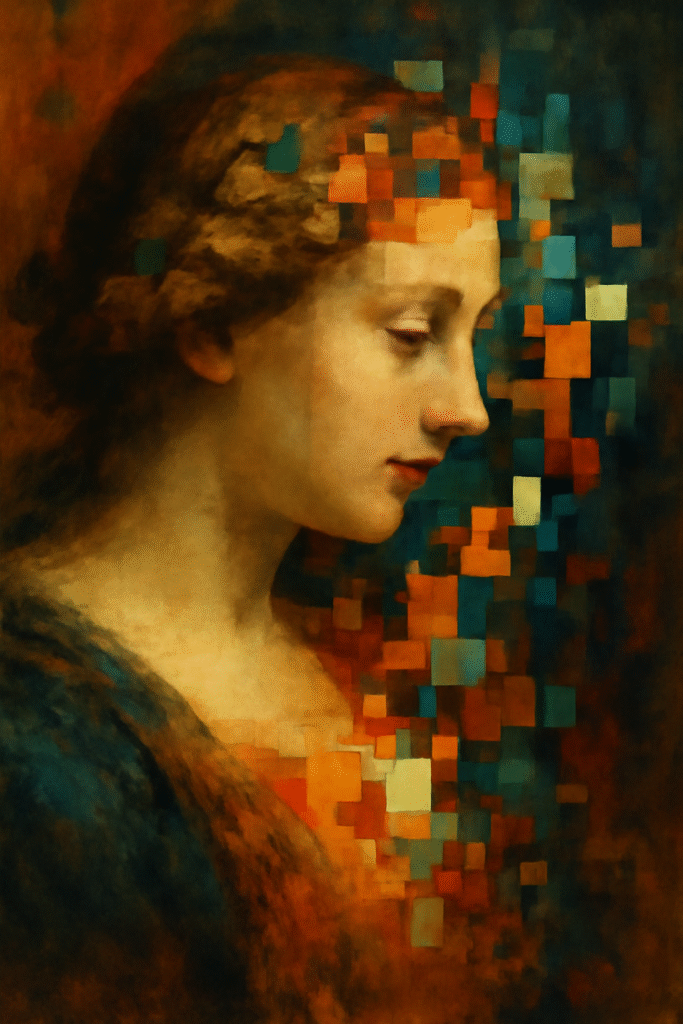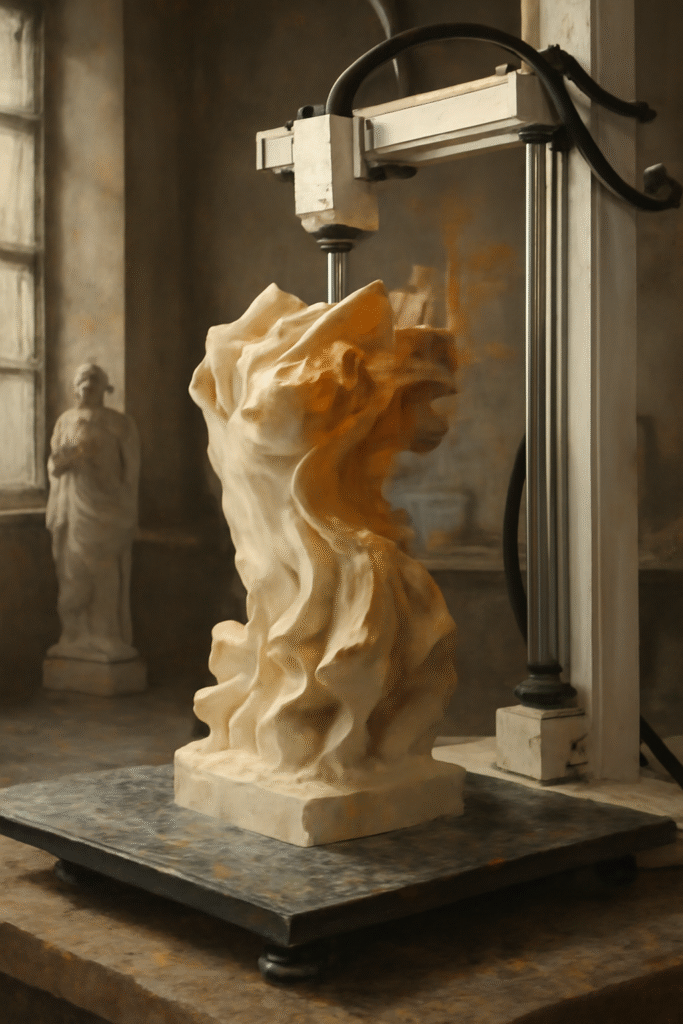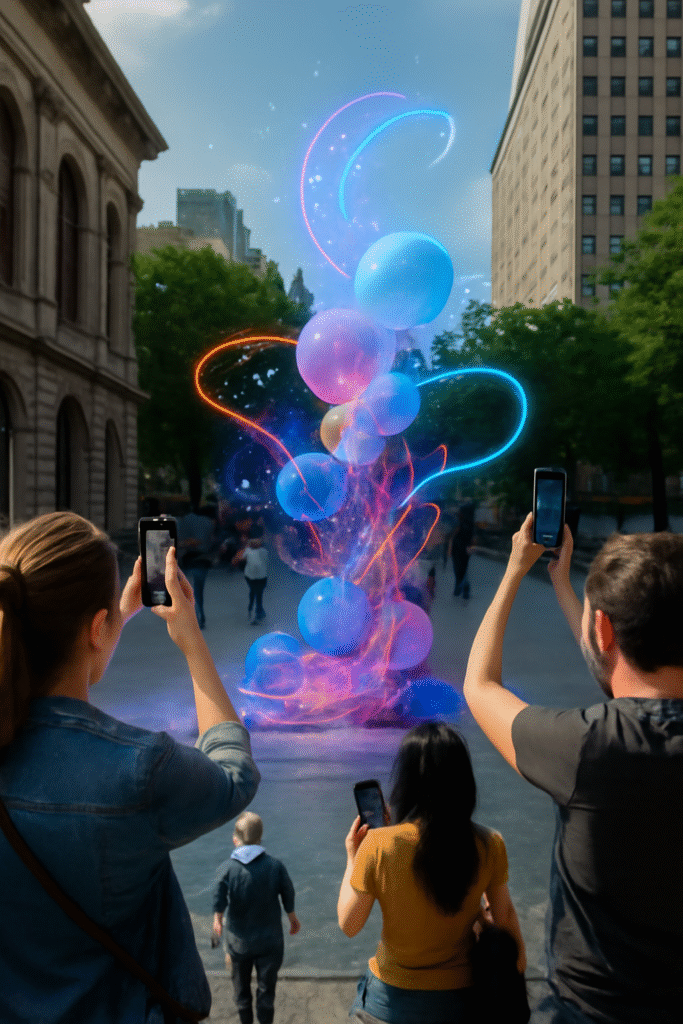Quando a tradição encontra o píxel — o que isso revela sobre nós?
A cultura sempre foi um espelho da humanidade — um registo de como sentimos, sonhamos e compreendemos o mundo.
Durante milênios, as pessoas expressaram as suas histórias por meio de pinturas rupestres, esculturas em mármore, manuscritos, teatro e música.
Mas agora, numa era em que os ecrãs mediam quase todos os aspectos da vida, a questão passa a ser: como a arte se transforma quando a sua tela é um ecrã e o seu pincel é feito de código?
A arte digital é muito mais do que uma novidade técnica ou um novo meio de comunicação.
É um ponto de viragem criativo que desafia a nossa compreensão da criação, originalidade e até mesmo propriedade artística.
Um único conjunto de pixels pode agora conter tanta emoção e significado quanto as pinceladas outrora.
Então, o que acontece quando a tecnologia não apenas auxilia a cultura — mas se torna parte dela?
O que é exatamente a arte digital? Surge uma nova linguagem visual

Na sua forma mais simples, a arte digital inclui qualquer expressão artística criada ou apresentada com tecnologia digital.
Isso pode significar uma pintura digital feita num tablet, uma escultura modelada com software 3D ou uma instalação interativa que reage ao som, movimento ou toque.
O seu poder reside na versatilidade — na dissolução dos limites físicos que antes confinavam a pintura, a música ou a escultura.
O estúdio do artista já não é definido por paredes ou materiais; é um espaço dinâmico de píxeis, algoritmos e possibilidades.
No entanto, a arte digital não substitui a tradicional; ela a reestrutura.
Quando a tecnologia se encontra com a técnica clássica, as antigas linguagens da arte evoluem em vez de desaparecerem.
Uma obra-prima digitalizada, quando reinterpretada num ecrã, obriga-nos a confrontar a própria percepção:
Como ver um fresco renascentista em realidade virtual altera como sentimos a sua cor, a sua escala, a sua alma?
Quando a tradição se funde com o píxel
A arte digital torna-se mais poderosa não quando imita formas do passado, mas quando as reimagina.
Aqui estão alguns exemplos vívidos dessa transformação:
1. Pintura e ilustração na era digital
Pintores que antes dependiam de óleo e tela agora experimentam canetas, estilos e ecrãs.
Artistas como David Hockney, outrora defensores das técnicas tradicionais, transformaram os tablets em novas fronteiras de expressão.
O ato de apagar, sobrepor camadas ou recolorir permite instantaneamente um nível de espontaneidade nunca possível.
Alguns críticos questionam se a facilidade de correção enfraquece a intenção artística, mas outros veem isso como uma libertação, um espaço onde a intuição e a precisão finalmente coexistem.
2. Pensamento escultural e criação 3D
Escultores digitais projetam formas complexas diretamente em programas de modelagem 3D e, em seguida, as transformam em realidade por meio da tecnologia de impressão.
Essa capacidade de criar formas que não poderiam existir manualmente confunde a fronteira entre imaginação e matéria.
Da mesma forma que a arquitetura, a moda e o design industrial já se beneficiam da criatividade computacional, a arte também descobre como a matemática pode se tornar sensual.
3. Fotografia e o poder da manipulação digital
A fotografia, outrora um retrato fiel do real, é agora um local de reinvenção.
Com ferramentas de edição, os artistas distorcem a luz, o tempo e a composição para construir mundos que pairam entre a documentação e o sonho.
Alguns artistas, como Andreas Gursky, ampliam imagens digitais em composições monumentais que parecem engolir a nossa visão.

Para além de reinterpretar a tradição, as tecnologias deram origem a novas formas de criatividade que simplesmente não poderiam existir antes do século XXI.
1. Arte Generativa
Aqui, o código se torna tanto ferramenta quanto colaborador.
Artistas e programadores escrevem algoritmos que geram, de forma autônoma, resultados visuais ou sonoros únicos a cada execução.
Cada resultado é irrepetível — uma conversa entre lógica e acaso.
Isso levanta questões profundas sobre autoria: a criatividade é produto da intenção humana, do processo da máquina, ou da dança entre os dois?
2. Arte em Realidade Virtual
Artistas agora constroem universos imersivos dentro de ambientes virtuais, onde o espectador não apenas observa — ele entra.
Museus inteiros estão sendo reinventados para VR, permitindo exploração infinita sem limitações físicas.
A linha entre público e autor se dissolve; o visitante se torna parte da própria tela.
3. NFTs e a Economia da Propriedade Digital
Com a tecnologia blockchain, o conceito de propriedade da arte mudou de posse para autenticação.
NFTs anexaram uma assinatura verificável a obras digitais que, de outra forma, poderiam ser copiadas infinitamente.
Essa inovação abriu novos caminhos para artistas digitais monetizarem seu trabalho, mas também despertou debates éticos sobre custo ambiental, especulação e o significado de “valor” quando a abundância substitui a escassez.

Toda revolução artística remodela a maneira como pensamos a própria cultura.
A criação digital amplia essa reflexão, mostrando que cultura não é um arquivo estático, mas um processo orgânico que se adapta continuamente às suas ferramentas.
Democratização da Criatividade:
Tecnologias acessíveis colocam a criação nas mãos de todos, reduzindo a distância entre amadores e profissionais.
Essa nova abertura estimula a diversidade e redefine o que conta como excelência artística.
Acessibilidade Global:
Uma obra digital pode alcançar públicos instantaneamente através de continentes, ultrapassando barreiras tradicionais de museu, geografia ou privilégio.
A experiência da arte torna-se compartilhada, portátil e inclusiva.
Autoria Fluida:
Quando obras podem ser remixadas infinitamente, a ideia de um “original” se dissolve em redes de inspiração.
O que começa com um artista pode evoluir de forma comunitária, refletindo a natureza coletiva da cultura online.
Desafios de Preservação:
Como a arte digital depende de softwares e hardwares específicos, sua conservação futura exige novas estratégias.
O que acontece quando programas ou sistemas operacionais desaparecem?
Os guardiões da cultura em breve precisarão arquivar não apenas objetos — mas as tecnologias que lhes deram vida.
O Futuro Não É Digital ou Tradicional, É Híbrido
A arte digital não está substituindo as tradições que vieram antes; ela está ampliando o espectro da expressão cultural.
O píxel e o pincel agora compartilham a mesma missão: interpretar a emoção humana por meio de ferramentas em constante transformação.
Estamos em um momento em que a inovação honra a história, e onde a criação flui entre código e tela.
A arte na era digital nos ensina que cultura é uma conversação, não um destino — sempre evoluindo, infinitamente remixável, profundamente humana.
Então, podemos nos perguntar:
Neste novo mundo híbrido, onde vive a sua criatividade — na tela, na mão ou em algum lugar entre as duas?
